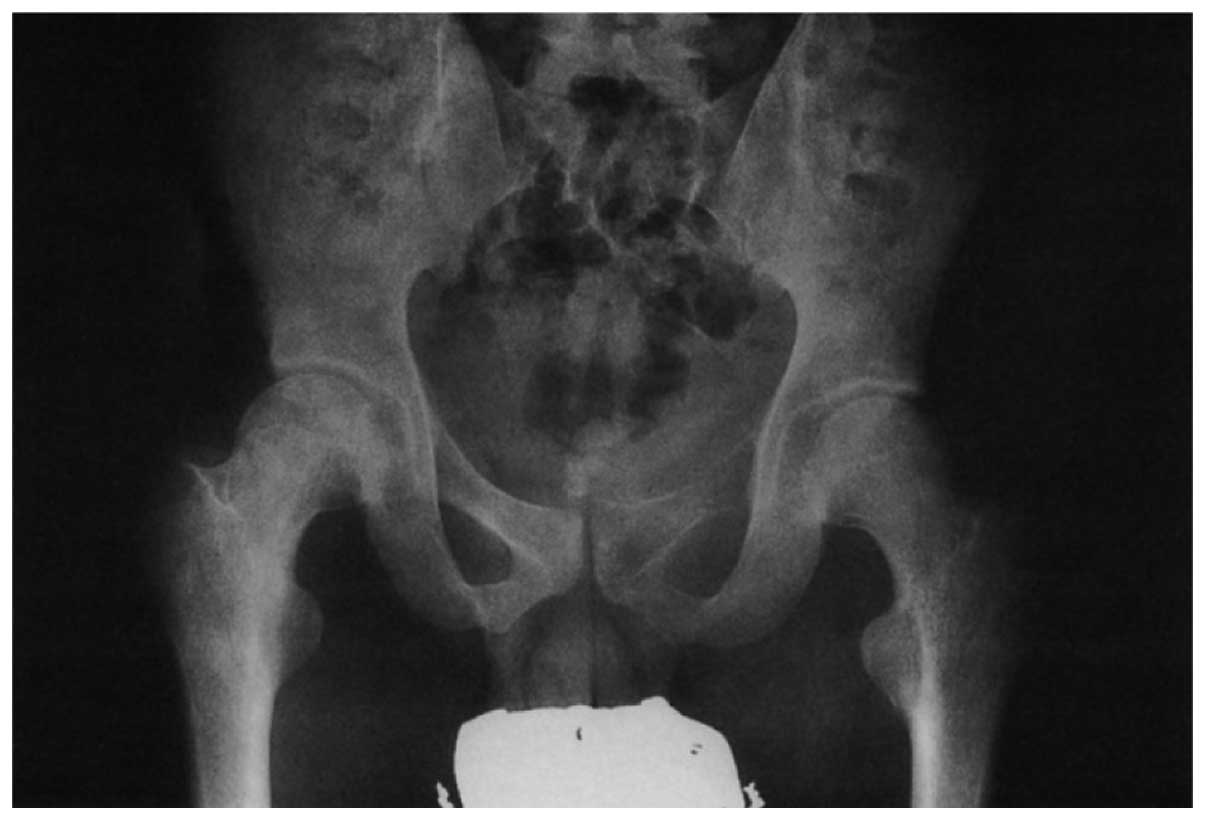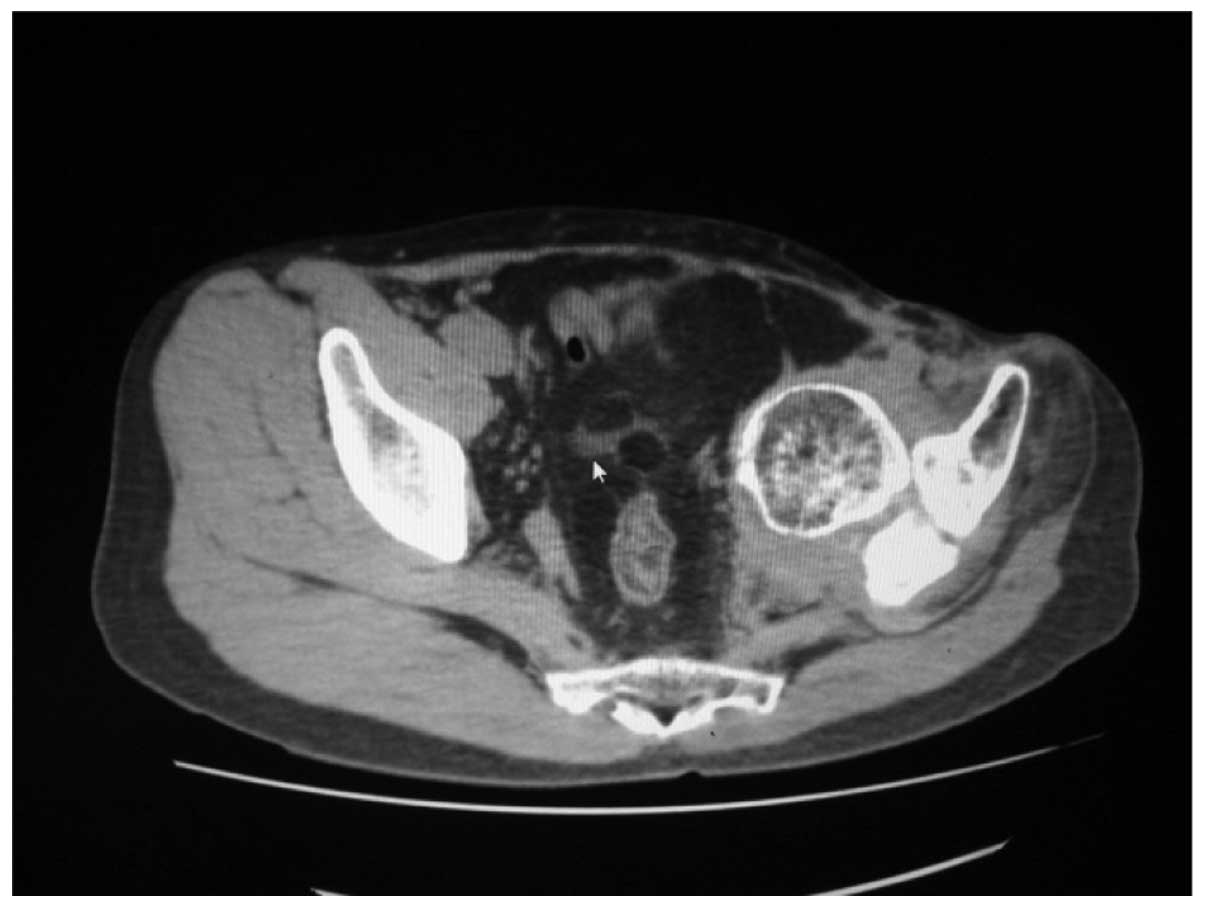Introduction
Reconstruction following periacetabular tumor
resection of the pelvis is a major challenge in orthopedic
oncology. There are several reconstruction methods available,
including arthrodesis (1,2), pseudoarthrosis (1–3), resection
arthroplasty (4–6), prosthetic arthroplasty (7,8), saddle
prosthesis (9) and hip transposition
(10). Most of these reconstruction
methods have associated complications. The most common
complications are deep infection, wound skin necrosis and aseptic
loosening of implants. At Osaka City University Hospital (Osaka,
Japan), doctors have been using the method of flail hip joint
without reconstruction. Compared with the results obtained with
other types of reconstruction methods, complication rates with the
flail hip joint method appear to be acceptable, and enable
relatively good extremity function (11). In the present study, we describe the
case of a patient with excellent extremity function as observed on
a long-term follow-up. The simple and highly effective procedure is
described below.
Case report
In August 1993, a 20-year-old male fell while
driving a motorcycle. As pain subsequently developed in the left
inguinal region, he visited the Department of Orthopedic Surgery at
Osaka City University Hospital for treatment. Radiography revealed
an osteolytic lesion in the left pubis, ischium and acetabulum
(Fig. 1). After an open biopsy
revealed Ewing sarcoma, preoperative radiotherapy (61 Gy) and
chemotherapy were administered. In February 1994, the tumor was
resected, and a flail hip joint was implemented. At that time, we
placed the head of the femur inside the pelvis using the upper
surface of the femoral neck as a saddle facing the remaining ilium
in order to provide bony support (Fig.
2). The concavity of the upper surface of the femoral neck
articulated well with the remaining ilium (Fig. 3). The patient had a deep infection and
was conservatively treated with irrigation and antibiotics. He
demonstrated a good recovery within a month. He is now working at a
shop 20 years after the surgery. Although the patient has a 5-cm
leg-length discrepancy, he is able to walk several hundred meters
using a 5-cm shoe lift but without a cane.
Written informed consent was obtained from the
patient for publication of this case report and the accompanying
images. The study was approved by the ethics committee of Hanwa
Sumiyoshi General Hospital (Osaka, Japan).
Discussion
When treating patients with tumors that require
sacrificing the acetabular region in the pelvis, our hospital has
been performing the flail hip joint procedure rather than
reconstruction surgeries. High complication rates have been
reported with various types of reconstruction procedures. The
common complications are wound healing, aseptic loosening of the
implant and, most frequently, deep infections. Hillmann et
al (12) reported a complication
rate of 50% in 110 patients following reconstruction, with
complications including infections, skin problems and hematoma.
Abudu et al (7) reported a
complication rate of 60% in 34 patients, with complications
including infection, dislocation and visceral injury. We consider
that it is best to avoid the use of foreign parts as much as
possible in order to avoid infection. For this reason, the flail
hip joint is considered to be the optimal procedure. We also
support the work of Gebert et al (13) who used only small foreign parts when
they performed hip transposition.
One disadvantage of the flail hip joint is the
resulting high leg-length discrepancy. However, when the femoral
head moves upwards, dead space decreases and operative wounds are
likely to heal more easily. After patients are cured of the
sarcoma, it is possible to perform limb lengthening via callotasis
(10). In a variety of reconstruction
methods following acetabular tumor resection, certain surgeons
resect the femoral head and neck (4,5,14). Other surgeons do not resect the
femoral head (6,10,11,13,14).
In cases in which the femoral head is not resected, extensive
surgical procedures might cause blood supply loss to the femoral
head and result in avascular necrosis of the femoral head.
When treating the present case, we did not resect
the femoral head and neck, but used the upper side of the femoral
neck as a saddle. Computed tomography revealed osseous resorption
and formation, indicating an avascular necrosis-like lesion of the
femoral head (Fig. 2). However, we
consider that weight bearing might be transmitted between the upper
side of the femoral neck and the remaining ilium. We believe that
even if femoral head necrosis is observed in these cases, it is not
related to the functional outcome.
The Musculoskeletal Tumor Society (MSTS) score
(15) in our case was 27 points
(90%). The MSTS score is scored as 0–5 for six categories
(emotional acceptance, function, pain, walking ability, support and
gait). The score of this patient was notably high (90%) when
compared with the mean MSTS scores of different reconstruction
methods, which range from 30–70% (2,4,6–10).
We consider that this procedure should be limited to
cases in which the uninvolved acetabular region is capable of
providing sufficient bony support. However, the use of the flail
hip joint using the upper side of the femoral neck as a saddle is a
simple and effective method.
References
|
1
|
Enneking WF and Dunham WK: Resection and
reconstruction for primary neoplasm involving the innominate bone.
J Bone and Joint Surg Am. 60:731–746. 1978.
|
|
2
|
Fuchs B, O'Conner MI, Kaufman KR, Padgett
DJ and Sim FH: Iliofemoral arthrodesis and pseudoarthrosis: a
long-term functional outcome evaluation. Clin Ortho Relat Res.
397:29–35. 2002. View Article : Google Scholar
|
|
3
|
Steel HH: Partial or complete resection of
the hemipelvis. An alternative to hindquarter amputation for
periacetabular chondrosarcoma of the pelvis. J Bone and Joint Surg
Am. 60:719–730. 1978.
|
|
4
|
Schwartz AJ, Kiatisevi P, Eilber FC,
Eilber FR and Eckardt JJ: The Friedman-Eilber resection
arthroplasty of the pelvis. Clin Orthop Relat Res. 467:2825–2830.
2009. View Article : Google Scholar : PubMed/NCBI
|
|
5
|
Pant R, Moreau P, Ilyas I, Paramasivan ON
and Younge D: Pelvic limb-salvage surgery for malignant tumors. Int
Orthop. 24:311–315. 2001. View Article : Google Scholar : PubMed/NCBI
|
|
6
|
Kusuzaki K, Shinjo H, Kim W, Nakamura S,
Murata H and Hirasawa T: Resection hip arthroplasty for malignant
pelvic tumor. Outcome in 5 patients followed more than 2 years.
Acta Orthop Scand. 69:617–621. 1998. View Article : Google Scholar : PubMed/NCBI
|
|
7
|
Abudu A, Grimer RJ, Cannon SR, Carter SR
and Sneath RS: Reconstruction of the hemipelvis after the excision
of malignant tumors. Complications and functional outcome of
prostheses. J Bone and Joint Surg Br. 79:773–779. 1997. View Article : Google Scholar
|
|
8
|
Ueda T, Kakunaga S, Takenaka S, Araki N
and Yoshikawa H: Constrained total hip megaprosthesis for primary
periacetabular tumors. Clin Orthop Relat Res. 471:741–749. 2013.
View Article : Google Scholar : PubMed/NCBI
|
|
9
|
Renard AJ, Veth RP, Schreuder HW,
Pruszczynski M, Keller A, van Hoesel Q and Bökkerink JP: The saddle
prosthesis in pelvic primary and secondary musculoskeletal tumors:
functional results at several postoperative intervals. Arch Orthop
Trauma Surg. 120:188–194. 2000. View Article : Google Scholar : PubMed/NCBI
|
|
10
|
Gebert C, Wessling M, Hoffman C, Roedl R,
Winkelmann W, Gosheger G and Hardes J: Hip transposition as limb
salvage procedure following the resection of periacetabular tumors.
J Surg Oncol. 103:269–275. 2011. View Article : Google Scholar : PubMed/NCBI
|
|
11
|
Takami M, Ieguchi M, Takamatsu K, Kitano
T, Aono M, Ishida T and Yamano Y: Functional evaluation of flail
hip joint after periacetabular resection of the pelvis. Osaka City
Med J. 43:173–183. 1997.PubMed/NCBI
|
|
12
|
Hillmann A, Hoffmann C, Gosheger G, Roedl
R, Winkelmann W and Ozaki T: Tumors of the pelvis: complications
after reconstruction. Arch Orthop Trauma Surg. 2003:340–344. 2003.
View Article : Google Scholar
|
|
13
|
Gebert C, Gosheger G and Winkelmann W: Hip
transposition as a universal surgical procedure for periacetabular
tumors of the pelvis. J Surg Oncol. 99:169–172. 2009. View Article : Google Scholar : PubMed/NCBI
|
|
14
|
Nilsonne U, Kreiberg A, Olsson E and Stark
A: Function after pelvic tumour resection involving the acetabular
ring. Int Orthop. 6:27–33. 1982. View Article : Google Scholar : PubMed/NCBI
|
|
15
|
Enneking WF, Dunham W, Gebhardt MC,
Malawar M and Prichard DJ: A system for the functional evaluation
of reconstructive procedures after surgical treatment of the
musculoskeletal system. Clin Orthop Relat Res. 286:241–246.
1993.PubMed/NCBI
|

















